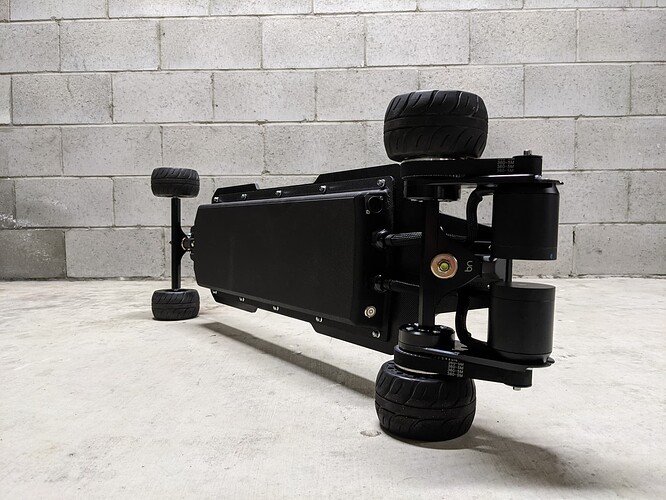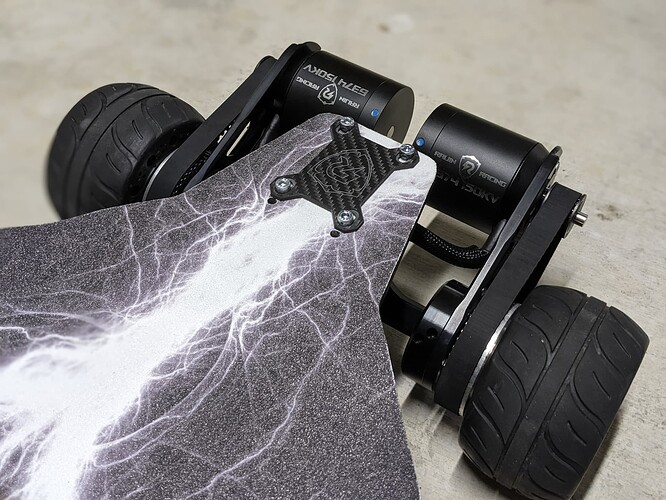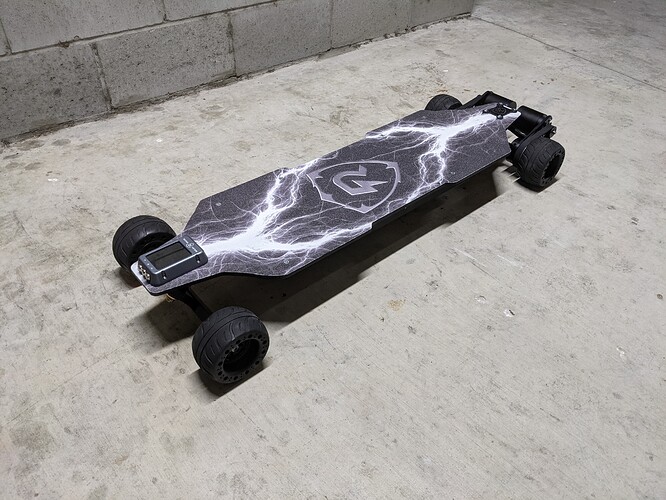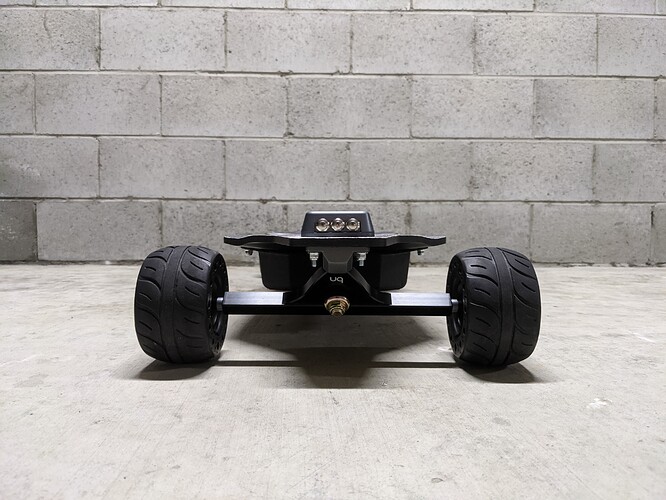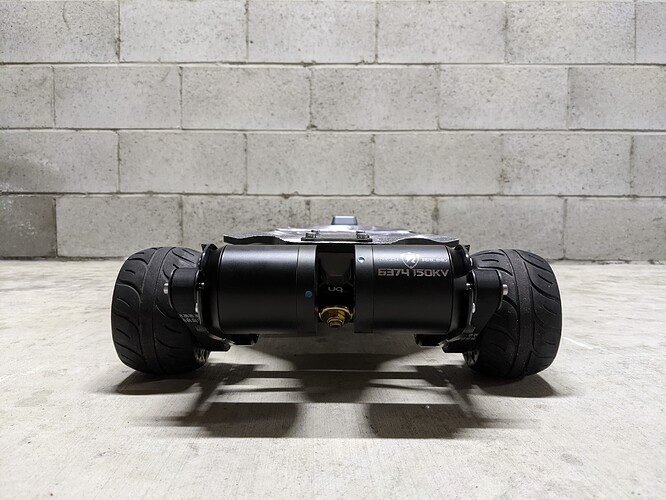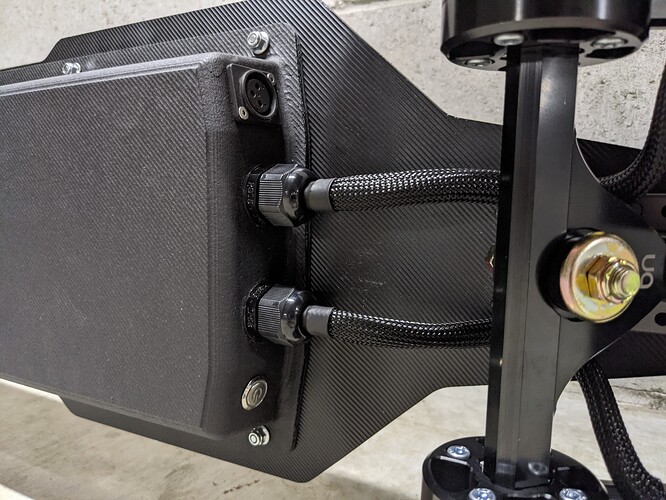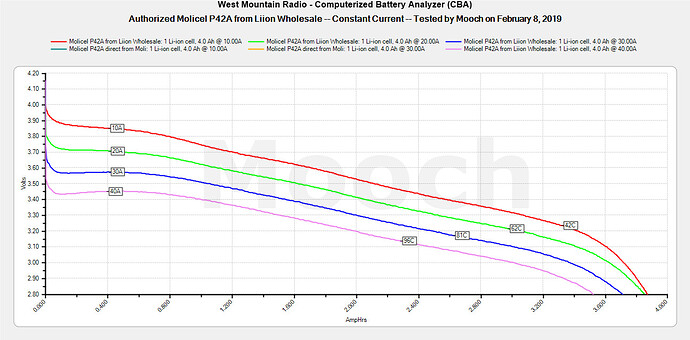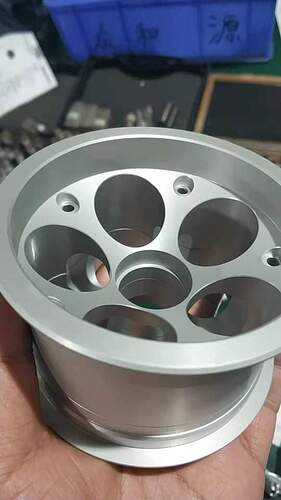@Battery_Mooch do you have some input for peak ratings?
Most important…there’s no such thing as an independent or “universal” peak/pulse/max rating. ![]()
If you defined what is acceptable to set the rating, the criteria for the rating for your application and your priorities, then a rating could be set.
Any cell can be used a discharge current level that is far, far above its continuous current rating. But how far is determined by your priorities. Do you care about cell heating and cycle life? Is voltage sag a concern? These will affect what level you can bring the cells up to.
The length of the bursts of current and how often the bursts occur also have a huge effect on what the rating might be. A one-second pulse at 100A is survivable by many high-performance round cells. It ages the cell quickly but the cells survives.
If you do that burst once every five minutes then the cell might actually have a sort of useful cycle life. If you do that burst every five seconds you could have some real problems on your hands if the cell is not actively cooled.
The P42A is rated by E-One Moli 45A for non-continuous use but the datasheet notes that it will reduce cycle life. So while you could run your cells at 45A it’s not a rating you can compare to other cells with ratings that are not abusive.
For efficient operation, good cycle life, and reduced risk I recommend staying under 30A. At above that your cycle life takes a hit (even if pulsed) and the sag gets worse and worse.
That may be perfectly okay for your use though! Each of us has to determine what we accept from our cells and plan out our packs (or how we will use them) accordingly.
If you are using them at 45A and the performance and run time of the pack is acceptable, and the cells in the middle of the pack are not getting much above 45°C (a bit warm), then you’re probably okay. Well, as long as the cells are not otherwise being abused (charging, storing, vibration, etc.) and you lower the discharge rate as the cells age and get hotter during use.
It seems you fully understood my point.
Even if your basing your math’s off power system numbers, 9kw is not a realistic rating for a system like this.
Even if you can get 135A from this pack it will have to be at high duty cycle so that motor current limits are not the limiting factor. This means you will already need to be at speed and the battery will already be under load so the voltage would have dropped.
if you’d said 6Kw i could totally see that as a feasible with your current setup.
For reference I have an 18S4P P42a with larger motors and the most total system power I’ve ever managed to log is 6.5kW, and that’s a lot. Only a few here have managed to log system power numbers that high. none of those guys running boards with similar spec to yours.
Okay thank you, I understand most of this. I guess my main question would be how much the voltage might sag under max load of 45a/cell for 3 seconds or so. Without knowing full pack resistance, this seems the best way to estimate the peak power output at full charge.
All the data sheets I’ve seen (in minutes) instantly drop to nominal voltage. Had to take something out of that
At 45A a new and freshly charged Molicel P42A will probably drop to about 3.35V-3.40V or so for the first 3 second pulse. Of course that will rapidly drop as the cell discharges (from just cruising) and as the cell ages over time.
This does not take all the other resistances into account! Your cell interconnect (nickel strip, solder connections) and wiring resistances could add a lot of voltage drop. It will certainly add some.
i get how it works under load and duty cycle, I’ve seen pretty high power levels with some load tests in real life and burnt some parts doing it. however, I don’t have a logging device I either watch vesc tool or use the davega as the basis. So It could be wrong.
Not very scientific, I know, but I can also ‘feel’ acceleration differences after changing battery current settings, at high duty cycle which should be representing power output from the battery. Using my 12s5p demonseed for testing that at 100, 150, 200, 225 amps. If it were just sagging ridiculously I wouldn’t feel any difference. Right?
Right, I certainly haven’t noticed this amount of voltage drop in real life but again my data can absolutely be wrong. I would really like to build a dyno and abuse the entire system to see what really happens.
I’ll lower the expectation in the interest of not being unrealistic 
I’ve come across this, and it looks like momentarily the Molicell p42a could support up to 250w for one second, maybe around 200w for 3 seconds. If I said the pack would do 9000w, thats about 180w per cell. Lots of very different information around
i will take mooch’s word over any oem cell datasheet
Preach
Of course there is different info…for different uses of a cell.
I posted those Molicel graphs so it doesn’t contradict anything else that was said. ![]()
Just about any really good high performance cell can put out a single 250W pulse for one second. It speeds up aging of the cell and you must let it cool down before doing that again but it can certainly be done. The cell is probably going to be at around 3V or lower when pulsed though.
Add on the large voltage drop from the nickel, soldered connections, and the wiring and connectors and you have hit the low voltage cutoff of your BMS/ESC on the first pulse.
This is completely different from its continuous (from me) and non-continuous (from Moli) ratings. My rating is an estimate of what would allow for continuous running while not having excessive voltage sag and heating and still having a decent cycle life. My rating is not a hard limit of some kind.
Moli’s 45A rating is also not a hard limit. It is how hard you could run the cell if you don’t let it get hot and you don’t mind lots of voltage sag along with a shorter cycle life (according to Moli).
There is a huge difference between a single pulse capability and a practical rating. You are looking to justify a 9kW claim for your pack. The cells could do it if you don’t care about voltage…and if they weren’t in a pack with interconnection and soldering and wiring resistances…and you don’t care about cycle life…and you only pulsed the cells once. Of course. But in a pack and being used for esk8 means we probably can’t run them at 180W.
Every cell can be given a rating over a huge range of discharge current levels. It all depends on how much safety, performance, and cycle life you want. My ratings allow for a direct comparison of cells and decent performance and cycle life. The manufacturer’s ratings allow for the cycle life spec in the datasheet and, occasionally, note when their ratings are high enough to affect cell life. But up to a point (before it becomes dangerous) you can use a cell much harder than that if you don’t mind the voltage sag and short cell life.
How hard you can use a cell also changes as the cell ages. My ratings and those from the manufacturer take that into account. Those ratings are still the same for the life of the cell. Pulsing at super high power levels can’t be done as safely for a older cell.
Get some gear and measure the voltage of your pack and the current it puts out! Discussing theoretical capabilities and ratings won’t help us determine what power levels we can claim for a setup. Only testing can do that. ![]()
Just another bit of data…here’s a 40A discharge. The voltage drops instantly to about 3.5V (about 140W). That is a bare cell without any weld point, nickel, soldering point, wiring, or connector voltage drops. How all that adds up means we can’t even remotely call these 140W cells for esk8 use. Moli notes that you get shorter cycle life when used this hard too. Any cell can be abused to get more power. But we need to make sure it’s still useful power and not a standalone theoretical number.
I’m with you, I’m not looking to justify anything, just piecing info together about what’s possible. I’m only going to run the cells at 30a because of the voltage drop at 45a, and I’m not going to claim anything about the battery output.
Until I can get a dyno together or access to one where I can see the entire systems behaviour. Thanks for chiming in again 
Find a fat friend, a hill, and a rope. Drag him up the hill and collect logs. Share. /thread
That would be the same as just testing really difficult gearing to produce the same load on the system. Its not enough, need an accurate way to test specific loads etc
Build a Dyno?
yeah, want to make one you can strap the board too with rollers and adjust load.
Good way to stress test boards as QC too.
Would be a fun project to design a collaborative open source dyno for the DIY community
Prototype hubs on their way to me shortly, just clear anodised for these ones. What does everyone think about chrome plating? Possibly smoked chrome.
There will later be a small logo on one spoke either engraved or etched.
Five shooters incoming! Can’t wait!
